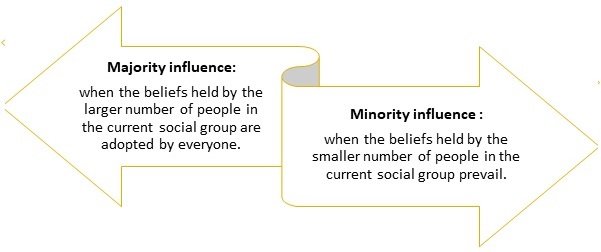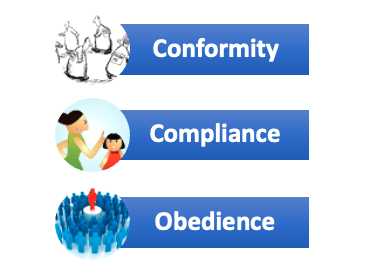Social Influence
Social influence is defined as the variation in an individual’s feelings, thoughts, attitudes, or behaviours that results from interaction with other persons or groups. It includes the impact of social media influences, politicians, celebrities, religion, community, and society at large.
Social influence is an essential determinant of attitudes and behaviour.
Influence on attitude
Social influence fulfils two types of psychological needs that lead one to conform to the opinions of society.
Normative Social Influence:
When we engage in normative influence, we conform to social norms about what we do or should do in particular social contexts. The outcome of normative influence is public conformity rather than private acceptance.
- For example, a man can offer a ladies’ seat to a woman in public transport due to the existing norms. Still, at home, he may have a different attitude towards his wife, where the patriarchal and regressive attitude is reflected in his actions.
Informational Social Influence:
It is defined as the change in opinions or behaviour that occurs when we conform to people whom we believe have accurate information. Informational conformity leads to fundamental, long-lasting changes in beliefs.
- It usually is private acceptance, which refers to a fundamental change in people’s attitudes.
- For example, Climate change reports by various organisations have influenced governments of multiple states to change their attitude towards the excessive use of fossil fuels with a rising inclination towards renewable energy resources.
Thus, we can say that normative and informational influence are not mutually exclusive.
For example, when children obey their elders, they probably do it both because others are doing it (normative influence) and because they think it is the right thing to do (informational influence). Thus, a person changes his attitude both in order to gain accurate knowledge (informational influence) and to avoid being rejected by others (normative influence).
The change due to social influence may be caused because of either majority or minority influence.

When the minority beliefs are consistent and stable over long periods, the minority influence can overpower the majority influence.
For example, Revolutionary extremism was the minority influence of a few leaders during the freedom struggle, which impacted the masses. They adopted the method of self-sacrifice rather than peaceful participation.
In conclusion, we can say that the above theories prove the evident influence of socially accepted behavioural patterns on participants’ self-perception.
Factors influencing social influence:
- Dominance: Dominance is created by virtue of power power that ensures compliance and obedience. For example, people are often more likely to vote for a person with more muscle power than a person with better educational qualifications because a more powerful entity ensures compliance and influences voting behaviour. Similarly, celebrities wield social power to influence the society.
- Social Value and Scarcity: The utility and value of a scarce item are higher. For example, people are more fond of diamond jewellery than silver due to its scarcity, and its value is attached to social status.
- Reciprocity: Reciprocity activates an obligation coupled with a feeling of guilt when someone does not reciprocate when expected. For example, People often feel obligated to reciprocate favours if they think they owe something to someone.
- Medium of message: the nature of media plays a great role. An interesting novel or a Movie can create a great impact on society. Mass Media like radio and TV have greater social influence than public speech. For example, PM Mann ki Baat is a great media of social influence.
Means of Social Influence:
- Family: Families are the first institutions to have the power to act on behalf of the child. Their objectives are to secure the child’s future. To achieve these, a family should provide supervision by controlling the child’s comings and goings, relationships, and communications.
For example, children of Indian families generally follow the existing family beliefs, and they can have a negative view of any religion or personality that their family hates.
- School: School provides knowledge and skills and a safe and supportive environment for children. This not only develops cognitive skills but also social skills. A child learns more from peers than the teachers. It exposes a child to different ideas and perspectives, helping them to develop their values and beliefs. It also provides a sense of community and belonging;
For example, children of all castes, religions, etc., sit together without any discrimination, creating an attitude of brotherhood and equality.
- Religion: Religion is a code of conduct, a rule book that allows believers to function in a non-primitive manner.
For example, Catholic people are generally very conservative about abortion and same-sex marriages.
- Peer group: Influences thoughts, actions, attitudes, and behaviours on many social and cultural issues, such as drug use, driving etiquette, financial decision-making, political decision-making, etc.
For example, a person may feel pressured to smoke cigarettes just because the other members of their peer group are smokers.
- Media: Media provides an ability to reach a greater number of masses. Any government policy can be successfully implemented through media and public/social influence.
For example, The Swachh Bharat Abhiyan became a massive success due to repetitive appeals made by the prime minister through various Social media platforms. Social media Influence has become a new medium of social influence in an increasingly digitally interconnected world.
Types of Social Influence:
Social influence can take many forms, such as persuasion, compliance, conformity, etc. We shall see persuasion in the next article in detail, and other forms of social influence are dealt with here.
On the basis of the nature of the influencing authority, there are three main areas of social influence. Viz, conformity, compliance, and obedience.
Conformity:
Conformity is defined as the change in beliefs, opinions, and behaviours that results from our own perceptions about what other people believe or do. For example, we change our beliefs and values to be like those of our peers and admired superiors.
As conformity is a group phenomenon, factors like unanimity, group size, status, cohesion, prior commitment, and public opinion all help determine the level of conformity anyone will exhibit.
For example, when a person moves from village to city, he may change his/her speaking style to conform to the urban culture.
Reasons behind confirming the values of others:
- For a sense of security: People often conform from a desire to achieve a sense of security within a group—typically a group that is of a similar age, religion, culture or educational status.
- Ethical considerations: Conformity impacts the formation and maintenance of social norms and regulations and also allows society to function smoothly and predictably.
- Social Pressure: Sometimes, the person changes his behaviour because of the “pressure” from society, but this pressure can be real or imagined.
- Peer Pressure: Conformity can be seen as a safe means of avoiding bullying or deflecting criticism from peers.
Characteristics of Conformity:
- Presence of Community: Conformity does not require the real presence of the community; it is also affected by the “implied presence” of others or when other people are not actually present.
- Impact of Age: Conformity is mainly associated with adolescence and youth culture, but it affects humans of all ages. Any unwillingness to conform carries with it the very real risk of social rejection.
- Benefit for the Individual: This can have either good or bad effects depending on the situation. For example, driving safely on the correct side of the road is a beneficial example of conformity.
However, Social Influence does not always lead to conformity. Variables like psychological reactance (when individuals feel that their freedom is being threatened) have a significant impact on it.
For example, when a coercive method of birth control (forced sterilisation) was adopted by the government of India, it created a negative attitude in the Indian population. Later, when the same government of India promoted voluntary, non-invasive birth control methods, it was accepted with a positive attitude by the same population.
Compliance:
Compliance refers to the act of responding favourably to an implicit or explicit request offered by others. It is also referred to as a change in an individual’s behaviour, which is the result of a direct request made to that individual.
For example, children clean their rooms because their parents ask them to do so.
Characteristics of compliance:
- This direction may be explicit, like a direct request for donations, or implicit, like an advertisement exalting its products without directly asking for purchase.
- In all cases, the target recognises that he or she is being urged to respond in a desired way.
- Accompanies reward and punishment: Individuals may choose to comply or not comply, although the thoughts of social reward and punishment may lead to compliance when they really do not want to comply.
- ‘Compliance’ may or may not require an authority with power.
| Concept of Power: |
| Power is the capacity of an Individual to influence others’ behaviour, attitude and actions. This is often done by means of rewards and punishment. Power can have many dimensions, such as economic power, social power, political power, etc. |
Obedience:
It is a form of social influence in which an individual acts in response to a direct order from an authority figure, wherein without such an order, the person would not have acted in this way.
It is different from compliance in that it is obeying an order from someone that you accept as an authority figure. In compliance, you have some choice. In obedience, you believe that you do not have a choice.
Obedience involves a hierarchy of power or status. Therefore, the person giving the order must have a higher status than the person receiving the order. Obedience is the act of obeying orders from others.
For example, a soldier generally follows the orders of a superior officer.
Degree of Social Influence and Persuasion
On the basis of impact on an individual, Social Influence can be classified into 3 categories:
- Compliance:when people oblige to the directions given by the authority despite having a dissenting opinion. They keep their dissenting opinions private. For example, remaining inside the houses during a strict lockdown. People might want to go outside and yet choose to stay in.
- Internalisation:when people accept a belief of others as their own with enthusiasm, and there is no dissent whatsoever. For example, a religious group internalises the teaching of their master and identifies as an ardent follower.
- Identification:when people are influenced by the charisma of an individual or a group and identify their attitudes as being similar to others. For example, when a social media influencer starts a trend, the followers follow it.
Attitude, as we know, is an ‘enduring’ predisposition or tendency of an individual or a group, i.e. it cannot be changed easily. However, often, individuals and society at large harbour various negative attitudes that need to be changed. In this context, Social influence becomes an essential concept of psychology in the study of Ethics. We shall see its impact in the Persuasion chapter in greater detail.



